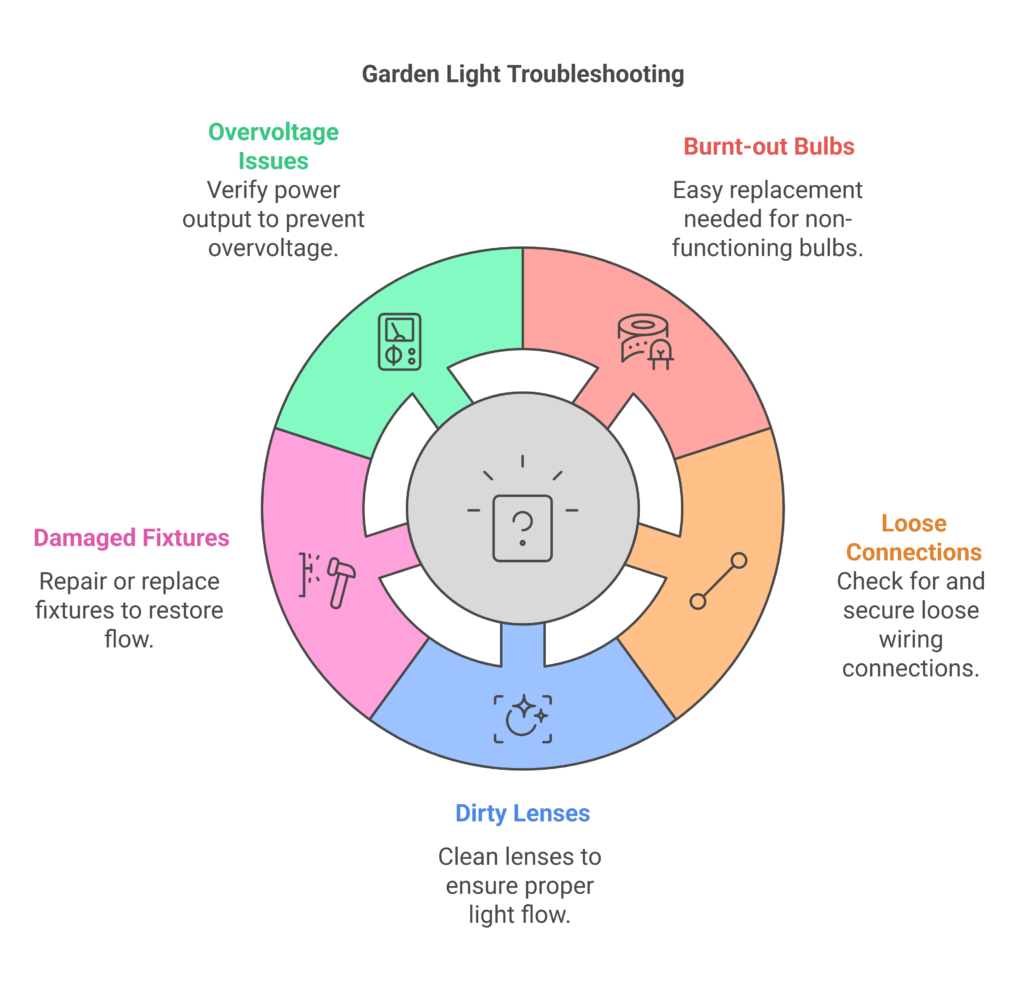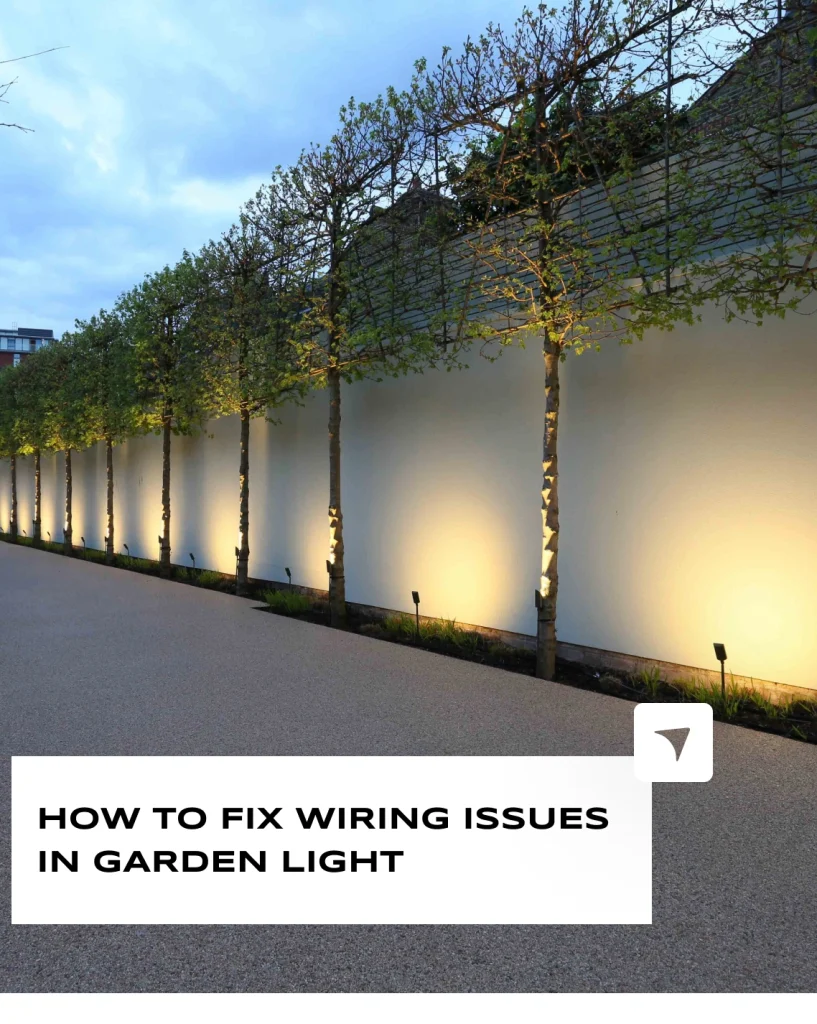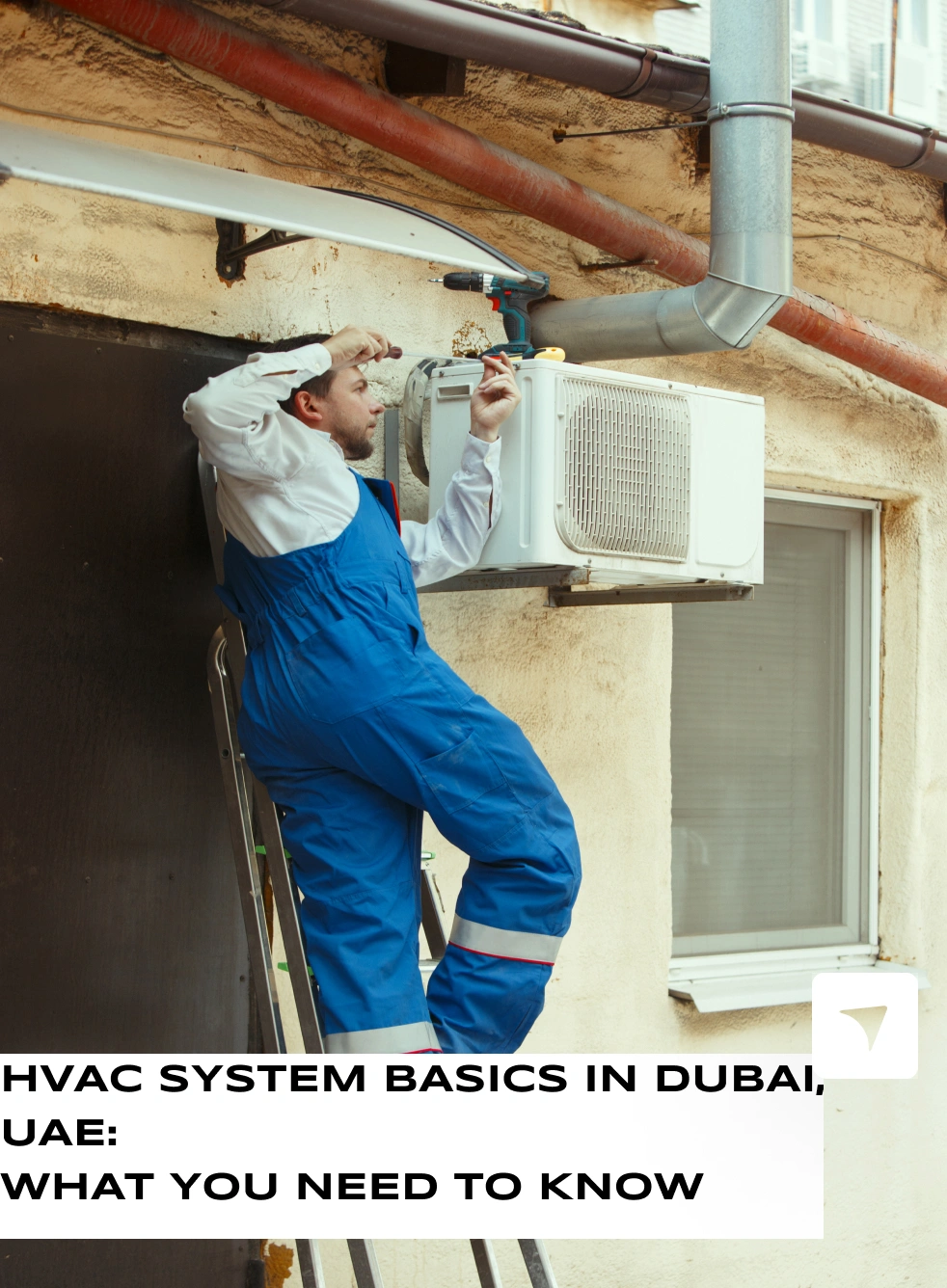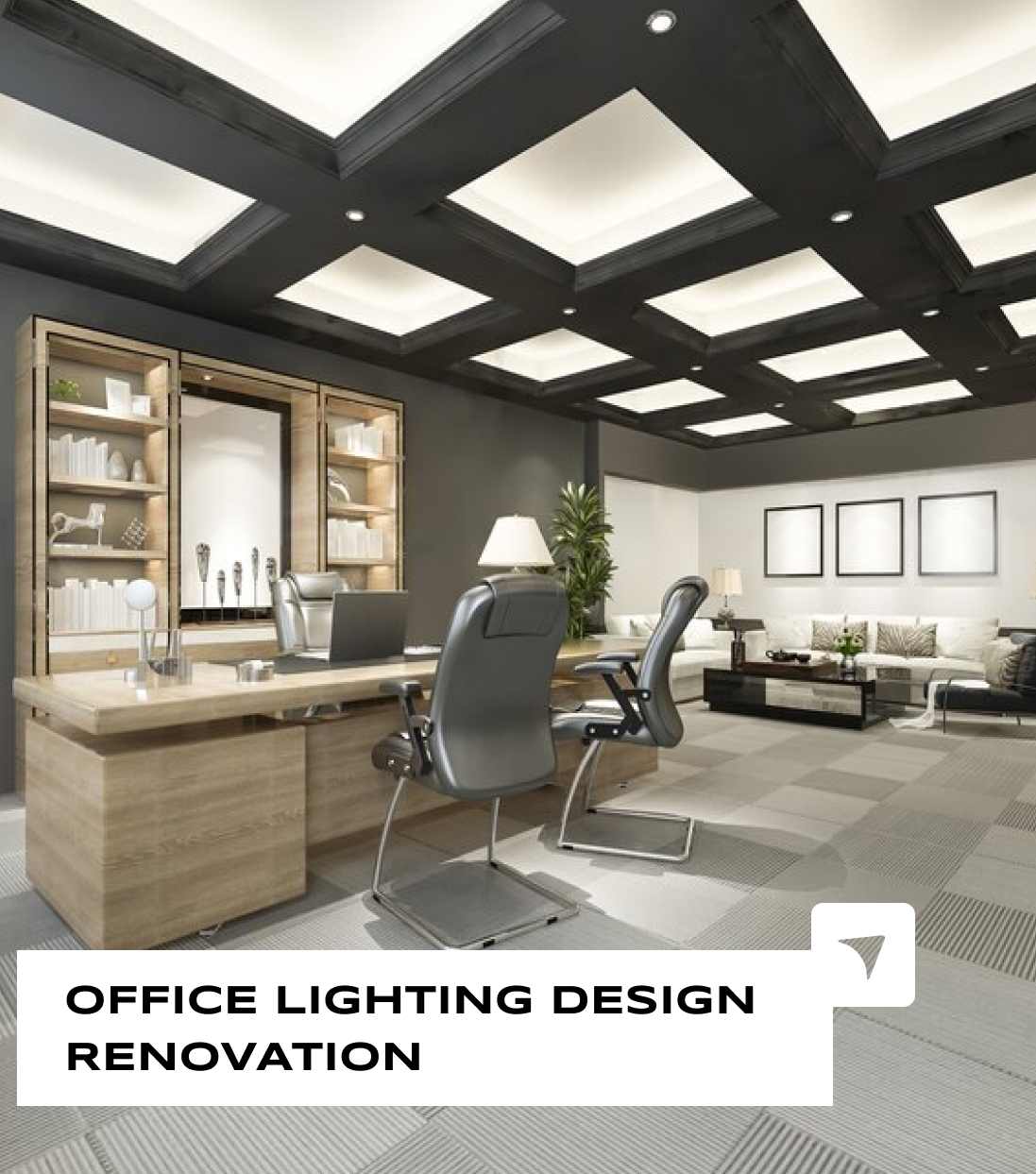Outdoor illumination has various applications, ranging from leisure to security. When you’ve created your ideal outdoor lighting setup, it may be irritating when anything goes wrong. However, there is constantly something you may attempt to restore your lights to full functionality. There are a few typical difficulties like fixture wiring and power setup issues with outdoor lighting, some caused by nature and others by human mistakes. Keep reading if you’re wondering what garden light issues to look for and how to solve them.
Garden Lights and Electrical Problems Troubleshooting
Perhaps the problem isn’t with the installations or lights but the electrical parts that run your outdoor lighting. Outdoor lighting troubleshooting sometimes entails inspecting the electrical wiring and power source to detect underlying issues. Begin with an electrical check to find apparent problems, such as loose or disconnected wires.
Identify Garden Lighting and Wiring Issues
It’s natural to get irritated when your outdoor decorative garden light quits functioning unexpectedly. However, several outdoor lighting solutions are simple once you’ve identified the issue. The typical faults include burnt-out bulbs, poor wiring, and unclean or broken fixtures. Before making any repairs, thoroughly evaluate the complete lighting system.
Begin by inspecting for burnt-out bulbs. This is usually the straightforward solution and the most prevalent issue. If your bulbs regularly burn out, it might be due to overvoltage, so make sure you’re using the proper voltage. Next, check the wiring. Lights that flicker or are dimmed may be caused by loose connections or exposed wiring. Ensure all wires are correctly connected and protected from moisture, which may damage them over time. Consider an overview of the most typical concerns to watch out for:
- Burnt-out garden bulbs require easy replacement.
- Loose connections and broken links in the electrical wiring.
- Filthy lenses obstruct the proper light flow.
- Damaged fixtures impede electrical flow.
- Overvoltage requires you to verify the power output.

A multimeter is used to measure the voltage at each lighting fixture. This will determine if the issue in one light is more or less detached from the wider problem. Detecting the issue as soon as possible will save you time and avoid more harm. Note any recurring concerns since they may signal a wider problem with the outdoor power system.
Identifying the Electrical Source:
Inspect the power supply to check that your lights are receiving adequate energy. Outdoor lights normally operate on low voltage, so if the transformer fails, your lights may fluctuate or go out completely. The initial phase in troubleshooting effectively is to identify the source of the problem. Instead of rushing into fixes, take your time to analyze and evaluate the issue.
This all starts with the main supply of electricity. Most outdoor lighting systems operate on either low voltage or line voltage. Low voltage often operates at twelve volts, which is secure and easy to install. The line voltage is twelve hundred volts, which is likely more powerful but should only be used by qualified professionals.
If the issue continues, you may need to contact an electrician. More complex problems, such as a faulty transformer or blown fuses, may need expert assistance to fix properly.
Find the Transformer and Checking Circuit:
A defective transformer or tripped circuit breaker is often the cause of non-working lights. Resetting the breakers and inspecting your transformer to determine any of these possible reasons.
If the wiring looks to be in good condition, but your lights are still not functioning, the issue may be with the connections. Improper wiring might not always be obvious. Connections may become loose over time or rust due to dampness. Firm up any loose electric wires and check the cable for indications of wear and strain. Replace any broken wires to restore the entire electrical supply to your lights.
A transformer for lower power voltage will be at the core of any outdoor lighting system. Check for tripped breakers, damaged fuses, or loose wire connections around the transformer. Check the other components to see whether your lights are one of multiple devices on a circuit and whether the whole circuit is operational. Restore electricity to any tripped circuit breakers and repair any blown fuses.
Visual Check on Wire Connections:
Connectors are how your lights connect to an electrical source. They are usually located in safe regions, away from possible threats like strong winds or storms. Exposure to the weather may cause difficulties such as fraying, which might lead to a fire. Due to these concerns, experienced lighting professionals should be contacted to address any issues in your outdoor lighting system. You should prioritize preventive measures and be alert for any indicators of disruption in your connections or wiring. Check for apparent damage, such as lamp failure, wire rusting, or loss of power connections. Water seepage penetrating lamps should be carefully monitored on outdoor transformers.
Identify Lighting and Electrical Upgrades
Outdated lighting systems may need more than simple maintenance. If your system routinely fails, it may be time for electrical changes in your house. Upgrading to contemporary elements, such as transformers and wiring, increases efficiency, dependability, and, ultimately, exterior appeal.
LED lights are the best option since they use less electricity and last longer. LED lights can optimize the functionality of your lighting system, but they also save long-term energy expenses. Reforming your arrangement will result in improved and more vibrant outdoor lighting.
Change Light Fixtures:
Frequently replacing old or broken components is the easiest approach to repairing outdoor lighting. If you see fluctuating or malfunctioning lights, start by replacing the bulbs. Carefully detach the outdated bulb and replace it with a compatible one. Disconnect the wire from the broken fixture, remove it, and securely install another one. To prevent water damage, ensure all connections are secure and the wiring is sealed. These modest changes may greatly enhance the functionality of your lights.
Low-Voltage Lighting Fixtures for Garden and Outdoor Spaces
Low-voltage LED fixtures are an ideal alternative to numerous outdoor lighting requirements because of their multiple advantages. Let’s see why low-voltage LED lighting for the garden runs more effectively:
LED lights are well-known for their energy efficiency. They consume less power and energy than standard lights, resulting in lower costs and cost savings. They function at a relatively low voltage, twelve volts, which reduces the danger of shock and improves safety. They do not produce heat or contain additional chemicals found in standard bulbs, which favorably influence the environment.
These lights last longer and need fewer bulb replacements. Unlike traditional bulbs, LED lights have no fading characteristics and may remain bright for hundreds of hours. These lights come in various sizes and colors, but regular bulbs may not.
LED lights are versatile; they may be utilized in various outdoor situations, including paths, gardens, porches, and structural illumination. Several low-voltage LED lights are compatible with automated home systems, enabling remote control, planning, and automation. Premium LED lights reduce fluctuation, resulting in consistent and pleasant lighting.
Illuminate Your Outdoors and Garden Space and Safe Lighting Repairs with REDO
Revitalizing your exterior environment with excellent outdoor lighting repair is simpler than you may believe. Whether changing lights, diagnosing electrical problems, or updating your system, these easy procedures can restore your garden’s radiance and increase safety.
REDO is one of the best lighting design companies, providing experienced troubleshooting services to ensure safe and efficient lighting in your exterior environment, as well as high-quality outdoor lighting maintenance and upgrades. Contact us now to see an improvement in your garden lighting and more!
Conclusion
Exterior lighting enhances both the aesthetics and functionality of your home. However, there are often unavoidable challenges that may seem overwhelming. Most difficulties may be readily handled by recognizing common concerns and using a methodical approach. Regular maintenance, including meticulous examination and cleaning, may help prevent many issues. You should get expert assistance if you believe your electrical difficulties are too advanced or if you are experiencing frequent failures. An outdoor lighting system that is properly maintained will continue to shine for many years.






